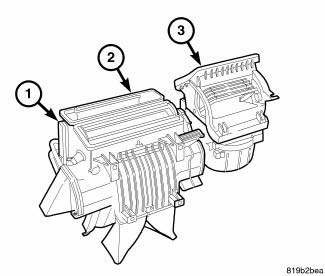Dodge Journey: Description

Fig. 90: HVAC housing assembly
NOTE: LHD model shown RHD model similar.
All models are equipped with a common HVAC housing assembly that combines A/C and heating capabilities into a single unit mounted within the passenger compartment. The HVAC housing assembly consists of three separate housings:
- HVAC housing - The HVAC housing (1) is mounted to the dash panel behind the instrument panel and contains the A/C evaporator. The HVAC housing consists of an upper and a lower housing that are attached together and has mounting provisions for the air inlet housing, blower motor and the air distribution housing.
- Air distribution housing - The air distribution housing (2) is mounted to the rear of the HVAC housing and contains the heater core, blend-air and mode-air doors and door linkage.
- Air inlet housing - The air inlet housing (3) is mounted to the passenger side end of the HVAC housing and contains the recirculation-air door and actuator.
The heating-A/C system is a blend-air type system. The blend-air door controls the amount of conditioned air that is allowed to flow through, or around the heater core.
The A/C system is designed for the use of a non-CFC, R-134a refrigerant and uses an A/C evaporator to cool and dehumidify the incoming air prior to blending it with the heated air. A temperature control determines the discharge air temperature by operating the electric blend door actuator, which moves the blend-air door. This allows an almost immediate control of the output air temperature of the system. The electric mode door actuator operates the mode-air door. The electric recirculation door actuator operates the recirculation-air door which closes off the fresh air intake into the HVAC housing and recirculates the air already inside the vehicle. The blower motor controls the velocity of air flowing through the HVAC housing assembly by spinning the blower wheel within the HVAC housing at the selected speed by use of the blower motor resistor or power module (depending on application), which is located on the bottom of the HVAC housing. The actuators, resistor or power module and the blower motor are connected to the vehicle electrical system by the instrument panel wire harness.
The air distribution housing must be removed from the HVAC housing and disassembled for service of the blend-air and mode-air doors. The air inlet housing must be removed from HVAC housing and disassembled for service of the recirculation-air door. The HVAC housing must be removed from the vehicle and disassembled for service of the A/C evaporator.
 Housing, HVAC
Housing, HVAC
...
 Removal
Removal
HOUSING-AIR DISTRIBUTION
WARNING: Disable the airbag system before attempting any steering
wheel, steering
column or instrument panel component diagnosis or service. Disconnect
and i ...
See also:
Installation
Fig. 32: Brake Booster Vacuum Hose
1. Position engine/transaxle assembly under vehicle and slowly lower vehicle
in short length spans. Inspect
at each interval for potential engine or transaxle ...
Wiring, trailer tow
DESCRIPTION
Fig. 73: Instruction Sheet Are Placed In Glove Box
Vehicles equipped with an optional Trailer Tow Preparation package have a
trailer tow wiring harness and an
instruction sheet (1) ...
Removal
FOOT OPERATED PARKING BRAKE LEVER
1. Release the parking brake.
2. Raise and support the vehicle.
3. Manually release the parking brake cable tension.
4. Push the front cable strand into ...
